 Royal Navy, Type 14 or Leopard-class frigates: 7 ships in Service 1957-2013*
Royal Navy, Type 14 or Leopard-class frigates: 7 ships in Service 1957-2013*RN: HMS Leopard, Lynx, Puma, Jaguar
RIN: INS Brahmaputra (ex-HMS Panther), Beas, Betwa
The Type 41 or Leopard class were a new type of British Royal Navy anti-aircraft defence frigates. It consisted only of four ships, whereas three more were delivered to the Indian Navy in the 1950s. The Type 41, together with the Type 61 sub-variant, introduced diesel propulsion for longer range, and reducing crew as well as maintenance and complexity. They were successful, but improvements in traditional steam turbine tech. Gradually decreased the fuel economy advantage of the diesel, so they were replaced by the better balanced Type 12 frigate, similar in overall design but with a more modern power plant.
Design Development of the Type 41 class Frigates
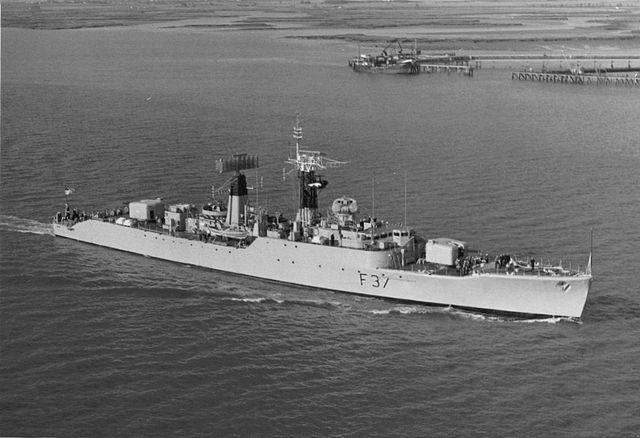
These Type 41 were designed, for the first time, not for ASW work as all their predecessors, but to provide AA escort work to convoys in case of war, and protect amphibious groups “east of suez” or act as light destroyers for detached duties.
They were never intended to follow the 28 kts+ fleet carrier task force, since like the destroyer escorts of WW2 she was limited to 24 knots (44 km/h). In fact the project went all the way back to 1945 notably as a potential successor to the Bay class AA frigates (river class derivatives). The initial project was for a series of brand new anti-submarine, anti-aircraft, and Aircraft Direction frigates sharing a common hull and propulsion. But the Type 41 as it evolved was completed by December 1947.
The new AA frigates drew some influence from the 1950 RAN Battle-class variant designed in Britain for war emergency production, the projected 1942 two-turret “G” destroyer that influenced also the 1944 Bay class Frigates, with a common hull between the Type 41 made by the Dennys Glasgow yard which provided the 1944 Gallant-class plans. Type 41, soon named “Leopard class” at least had a known specification, to carry two twin semi-auto 4.5″ Mk6 turrets. This represented a full destroyer armament, more modern, faster, more powerful and more accurate armament than the Battle or Weapon-class destroyers, on a smaller hull.
First production orders were for the 1951/2 as well as the 1952/3 programmes. In 1953, 11 additional Type 41s were ordered still named after “cat” (Cougar, Cheetah etc.) The plan also comprised ten Type 61 (Salisbury-class) frigates with a common hull and machinery. The Type 41 diverged from the Type 61 for its radar fit allowing a more complete coverage, for surface fighting, whereas the Type 61 was limited to Aircraft Direction. The Type 61 was, in short, a substitute for the WW2 Dido-class based, completely rebuilt HMNZS Royalist. The Leopard class similarly carried a new navigation radar, the Type 992 long-range surface target indication radar and Type 960M Long Range Air Warning radar. The Type 61 had the types 293, 977M, 960M and 982M.
Then there was a surface combat frigate (A/S) version Type 11. But it was cancelled, given the weak 24-knot top speed to follow fast carrier task forces. In truth, ASW work was a compromise in any case, given the technology of the time for frigates and destroyers at 25 knots+. The new method developed to hunt down the new fast Soviet SSNs was by helicopter with dipping sonar and magnetic anomaly detectors. The Type 41s received for ASW work the very best late-1950s sonars types 170 and 174, the latter still being regarded as a good passive sonar into the 1970s, but they lacked a helicopter and their A/S mortar battery was quickly obsolete.
Design of the class
Hull and general design
The Type 41 were large frigates, with tonnage equal to late British destroyer. Displacement was 2,300 long tons (2,337 t) standard and 2,520 long tons (2,560 t) full load compared to the nimbler Whitby class of 2,150/2,560 tons. She was however shorter at 340 ft (100 m) long overall versus 370 ft (110 m) for the Whitby, for the same beam at 40 ft (12 m) and lighter draught 16 ft (4.9 m). The extra weight was mostly the result of the two twin turrets and all their gear ad ammunition, plus heavier radars.
(Plans in research)
Design-wise, they still had the same hull shape, with a raised forecastle, full beam structure amidship, then main deck, ending with a lower deck and transom stern aft. The profile was defined by the two massive turrets for an aft. The bridge had the same standard shape found on other British frigates of the 1950s with a prominent central section for an observer. The main fire control tower was located on top of the enclosed bridge, followed by two lattice masts, both mounted on macks integrating exhausts from the four diesels each. The masts were also heavier and more developed than other frigates, and the use of counter-keels and stabilizer fins was hoped to counter the roll, expected greater than an average ASW frigate. Compared to a Whitbey class, the extra weight to manage was 150 tonnes.
Powerplant
One key aspect of the design was their diesel propulsion. The goal was to capitalize on powerful, yet compact diesels, to give them long range via larger tanks and low fuel use. Howeve given the average power of diesels at the time, this meant a true menagerie of the latter:
In all, no less than twelve Admiralty Standard Range Mk.1 (ASR1) were used. They were disposed in groups of four, split in three engine rooms.
The fore and aft engine rooms saw two engines connected to the drive shafts, by fluid clutches and reduction gearboxes. The other two were not connected to the shafts but drove 360 kW alternators to provide on-board electrical power. The centre engine room housed all four engines connected to the shafts.
These eight Admiralty Standard Range ASR1 diesels developed each 1800 bhp each for a total of 14,400 shp (10,738 kW) on 2 shafts. The fuel tank capacity was 220 tons.
This for the specific, contracted top speed of 24 knots (28 mph; 44 km/h), and a better range than ASW frigates at the time at 7,500 nmi (13,900 km) at 16 knots (30 km/h).
In addition, HMS Jaguar was the first fitted for tests, with a controllable-pitch propeller.
These diesels proved however unreliable at first, with teething issues un service, that were gradually overcome in the first decade, until reliability became very satisfactory. Overall, the experience of an all-diesel powerplant was satisfactory, but the need for more speed led to a gas turbine and diesel combo (CODOG) for later frigates.
The Type 41 were also fitted with an early type of hydraulic stabilizer system: There were two fins that could be extended outside, port and starboard, from a compartment between the two engine rooms. It was Gyro controlled, with a relatively simple control system, and proved very effective in use. Over three months, it was shown they could be brought artificially put to a 20°+ roll from the manual control on the bridge, or reduced to a similar roll, a test carried out after a warning to allow securing loose stowage and items. That was paid however in a slight top speed loss at flank speed due to the drag they cause.
If this new engine configuration was seen as a success, by 1955 the development of new steam turbines giving 30-knot with sufficient range for the Atlantic escort was applied on the Whitby-class or Type 12 frigates so follow-up Type 41 diesel-electric frigates were cancelled. Instead, Type 12 were ordered and the remaining in construction was sold to India.
Armament
The Type 41 were AA/A/S frigates and thus carrier a destroyer armament, with two twin, fast-firing 4.5 in main guns Mark 6 in turrets fore and aft.
This was completed with a single twin 40 mm Bofors gun STAAG Mark 2 and for ASW work, of a trusted Squid A/S mortar.
The issue with the Type 41 was that in a few years their armament was regarded as obsolete as anti-aircraft convoy escorts. The replacement of her 4.5″ guns with 3″/70 US AA guns was abandoned in January 1955 due to cost concerns, and general view that AA guns were bested by jets and missiles. At least the twin 4-5 in guns were to be upgraded with power-ramming for a better rate of fire from 14r to 24rpm, but the program fails to bring result.
This was completed by unreliable STAAG 40mm Bofors gun mounts. They were due for replacement by Seacat SAM, but this was cancelled on economic grounds. In the end, the twin STAAG were replaced by single and manually operated Mark 7 Bofors mounts.
Another planned change was to swap the experimental fast Type 992 target indicators by the slower standard Type 993, also cancelled.
The short range 262 radar MRS1 were adopted for secondary AA fire control, also applied to the main armament.
QF 4.5-inch Mk VI

The gun itself was designed from 1936 and operational in 1938, notably on aircraft carriers as main armament. It evolved considerably, and the Mark 6 was the result of a QF Mark V on mounting BD Mark VI. It was planned for the cancelled Malta class carriers. They however saw the adaptation to a new type of boxy turret and became the go-to late artillery system on 1950-60s British escorts, with the Leopard-class frigates and County-class destroyers having two, three for the Daring-class destroyers.
Specs:
Derived from the Mark V, it was designed from the outset for anti-aircraft use. It was given a remote power control (RPC, guns automatically trained and elevate towards the target as enslaved to the director) plus the highest rate-of-fire because it was assisted by automatic ramming. The mounting UD Mark VI had separate high-angle and low-angle hoists for two ammunition types, the AA and SAP/HE plus a third for cartridges. The rate of fire of the Mk V went up to 24 rounds per minute when power-loaded. It used a vertical sliding block for quick reload, semi-automatic, above 24 RPM recorded, power-loaded, 14 human loaded, 18 in burst mode, on the Mk VI UD mount, and a muzzle velocity beyond 2,449 ft/s (746 m/s), max range of 20,750 yd (18,970 m) at 2,449 ft/s (746 m/s) and a 41,000 ft (12,500 m) ceiling. The mount allowed a +80° elevation.
Read More
STAAG 40mm Bofors Mk.2
Like the Whitby the Leopard had STAG mounts, heavier than standard Mark 7 mounts, radar-assisted, but the Mark 7 were ultimately judged superior.
18 ton mounts, Gun Bore 1.57 in, rate Of Fire 240 rpm, max range 10,180 m. Integral Director, Power Operated.
Projectile Mass 21,2 kgs (warhead 0.9 kgs), muzzle velocity 881 m/s.
Squid ASWRL
The SQUID MORTAR/BOMB – Mk IV was a British Late World War II ship-mounted anti-submarine mortar composed of three tubes with limited elevation, launching automatically preset depth charges, replacing the Hedgehog. The Tobruk class had it installed on the starboard aft quarter. It was still present on HMAS Anzac in 1968 and at the end of her service, despite the fact it had been long replaced by the Limbo back in UK.
In brief, the Squid launched 390 pounds (177 kg) DCs topped with a 207-pound (94 kg) minol charge which had a sink rate of 43.5 ft/s (13.3 m/s), clockwork time fuse with last moment updates and max depth of 900 feet (270 m), creating a triangle pattern c40 yards (37 m) wide, 275 yards (251 m) ahead of the ship.
Sensors
Type 960 air search radar
Model operating in 450 kW VHF band long-range warning radar, fitted in cruisers as replacement of Type 281 series.
FRQ 86-90 MHz, PRF 250 Hz, pwt 5 and 15 µs, bmwt 35° with a range of 175 NM (≙ 324 km). It was soon replaced by the Type 965 AKE-1.
Type 293Q target indication radar
This WW2 legacy radar entererd service in 1945. It had a 500 Kw PP, FRQ 2,997, wavelenght of 100. Replaced by the Type 993 target indication radar.
Type 277Q height finding radar
Fry-pan style small ship radar, operating in S band for surveillance, height finding and surface warning. FRQ 2,940-3,060 MHz. PRF 500 Hz, pwdt 0.7 or 1.9 µs, PP 400 Kw, bwt 4.5°.
Type 974 navigation radar
Operating in the X band for surface search, pilotage and navigation, militarized Commercial Decca Marine Radar Type 12. FRQ 9,345-9,405 MHz, PRF 1000 Hz, pwt 0.14 or 0.26 µs, bwt 1.6°, PP 7 kW, range 25 NM (46 km), accuracy 2%
Type 275 fire control radar on director Mark 6M
Initially used on British cruisers in 1944-45. Used for the 4.5 in turrets. FRQ 3,450 to 3,614 MHz (F band), PRF 500 Hz, pwt 0.5 µs, PP 400 kW, range 16 NM (30 km).
Type 262 fire control radar on director CRBF
Developed in 1958 for use with the Sea Cat or 40 mm Bofors, as X band naval fire control radar. FRQ 9.67 GHz, PRF 1.5 kHz, pwdt 0.5 µs, bmwt 5.2°, PP 30 kW, range 29 NM (54 km).
Type 262 fire control radar on STAAG mount
Sae as above, part of the STAAG mount.
Type 1010 Cossor Mark 10 IFF
No data
Type 174 search sonar
Medium range passive search sonar. No more data.
Type 164 attack sonar
Introduced in 1950, fitted under a dome that was tear-dropped shaped. Inside was double faced oscillator that could be rotated electrically and either face of the oscillator could be shut off from the sonar control room. Frequency range 14 to 22 Kcs.

Conway’s depiction of Leopard in 1970 – Conways profile
⚙ Type 14 specifications |
|
| Displacement | 1180/1535 tonnes FL |
| Dimensions | 310 x 33 x 15 ft (94.5 x 10.1 x 4.6 m) |
| Propulsion | 1 shaft geared steam turbine, 2 B&W boilers 15,000 shp |
| Speed | 27 knots (50 km/h; 31 mph) |
| Range | 5,200 nmi (9,600 km; 6,000 mi) at 12 knots |
| Armament | 3x 40mm/60 Bofors Mk.9, 2x Limbo ASW Mark 10, 4× 21-in ASWTT |
| Sensors | Radars 974, 291, Sonars 174, 170, 162 |
| Crew | 112 |
Evaluation
For the remainder of the 1945 frigates, it was decided to adopt diesel propulsion because it was felt that so many steam plants would overstretch the capacity of British industry. The Type 41 AA frigate was intended to support the Type 12, along with its half-sister, the Type 61 AD version, and the first orders were placed in August 1951. The 41/61 in steam form was the basic design, and the Type 12 was developed from it. The raised forecastle of the Type 12 was adopted in order to enable speed to be kept up in a head sea, but was somewhat shorter and therefore lacking in elegance. Another unattractive feature was the absence of a funnel, for the diesel exhaust-trunking was brought up inside both lattice masts.
This proved unsuccessful as well as unsightly, and to prevent the corrosion of masthead equipment, Puma had her mainmast plated. The improvement was retro-fitted to the other ships. By the standards of the day, a most elaborate anti-aircraft defence was provided, with a Type 960 long-range air warning radar on the main-mast, a Mk 6M fire control system controlling two twin 4.5in automatic mountings backed up by a CRBF director aft, and a STAAG autonomous close-range 40mm mounting. The STAAG was not reliable, however. HMS Jaguar even entered service with a single 40mm gun in its place and the rest followed suit. Jaguar was the first to have the more effective Type 965 (AKE-1) long-range radar, but in time all four received it. A fifth unit, Panther, was sold (before being laid down) to India as Brahmaputra; a replacement was ordered, but subsequently cancelled. In 1978 Jaguar was transferred to Bangladesh as Ali Haider, followed by Lynx in 1982 (renamed Abu Bakr). Although effective ships when built, the Admiralty Standard Range 1 diesel was not a great success.
In service, they were used as patrol frigates, notably on the South American station. Given their range and destroyer-like appearance, they could fill that role at lesser cost (notably for crew and fuel consumption). They were also operating out of Simonstown naval base, South Africa, replacing the modernized Dido-class HMS Euryalus and Cleopatra deployed in 1946–1954. It was theorized in British circles that two Type 41s were adequate to deter a Russian Sverdlov-class cruiser, according to British intel seen to train on preying on trade routes from Buenos Aires to Britain and later in the Far East. They were especially present in the 1963–68 confrontation with Indonesia over Borneo and Malaysia.
In 1972 it was decided not to refit HMS Puma and instead she was replaced by Ghana’s Black Star, recommissioned HMS Mermaid. HMS Leopard was decommissioned after her tour in the 1976 Cod War, deterring an Icelandic gunboat by a demonstration of her armament. HMS Lynx was the operational. She was present at the Spithead fleet review in 1977. HMS Jaguar was reactivated for the third Cod War, but her hull was badly rusted, so many leaks were found underway she was recalled to Chatham.
HMS Jaguar and HMS Lynx were sold to Bangladesh Navy in 1978 and 1982, retained for a few more years for the Falklands where they could have been useful for specialized bombardment and AA defence in San Carlos Waters. They were still there in 1982 but budget constraints and issue saw having a single gun turret operating. The new power-rammed 4.5 inch Mk.8 often jammed. Plus the Mk.6 twin 4.5 inch required 40–45 men each. Tests were rare. The Bangladesh Navy still found them so satisfactory, they lingered about until… 2013.
Career of the Leopard class
 F14 HMS Leopard
F14 HMS Leopard
HMS Leopard was ordered on 21 August 1951, laid down on 25 March 1953 at HM Dockyard, Portsmouth. Her engines were provided by Vickers Armstrong (Engineers) Ltd, Barrow-in-Furness and Peter Brotherhood Limited, Peterborough. She was launched on 23 May 1955 and completed on December 1958 (commissioned 30 September 1958) at a cost of £3,545,000. First commanded was R.G. Gaunt, when she was deployed at the South Atlantic and South America station, as part of the 7th Frigate Squadron. In 1960, she sailed up 1,144 miles on the Amazon to Godajas. In 1961, she sailed for humanitarian relief at the island of Tristan da Cunha after a volcanic eruption. In 1963, she collided with the South African minesweeper Pietermaritzburg in exercises off Cape Point with one kill and serious damage, fixed at Simonstown for temporary repairs, then Portsmouth.
She was recommissioned on February 1966. In August, she was ordered to the Far East for many exercises. In 1967-1968 sunder command of N R D King she was diverted to Bermuda after civil unrest. She also took part of 1968 Portsmouth ‘Navy Days’. With the fishing dispute with Iceland in 1973 (Cod wars), Leopard was accused by Iceland of attempting firing on Ægir. The government denied these claims, and accuse the Icelandic trying to cut trawling wires of German fishing vessels Teutonia and Düsseldorf. She only fired warning shots across her bow. Then she provided more support for British trawlers in 1975, in a week of patrol. This proved to be her last mission as she was decommissioned and later scrapped at Dartford in 1977.
 F27 HMS Lynx
F27 HMS Lynx

HMS Lynx was ordered on 28 June 1951 to John Brown and Co Ltd, Clydebank with her engine provided by Crossley Brothers Ltd, Manchester and British Polar Engines Ltd, Glasgow. She was laid down on 13 August 1953, launched on 12 January 1955 and completed on 14 March 1957, commissioned the same day at a cost of £2,720,000. She became flagship of the 7th Frigate Squadron, between home waters and on the South Atlantic Station. On 3 May 1960 while in trials off Portsmouth, she was diverted to look for survivors of a disappeared fishing boat after a collision with the German tanker Caperata. In September 1964, as tensions flared up over the Falkland Islands: A rogue Argentine aircraft landed on Port Stanley racecourse, pilot Miguel Fitzgerald existed and planted an Argentine flag, handing a written proclamation of sovereignty before flying back. Lynx as part of a task group off South America was ordered to the Falklands and stayed on station from 14 October to 11 November.
In March 1967, the South Atlantic station was disbanded for cost reasons. Lynx was the last based at Simonstown naval base, South Africa, until leaving for the Far East. On 18 September 1970, she found an abandoned a barge adrift off the coast of Johor (Malaysia), towed to Singapore. On 30 December 1972 the Japanese cargo ship Kyoryu Maru sank underway to Singapore after a collision with the tanker Shoen Maru. Lynx was then on patrol off Singapore, and she also was part in the search for crew members. None was found. Lynx was paid off in June 1974. She had a refit at Rosyth, and joined the Standby Squadron at Chatham for the Cod Wars. She took part in the 1977 Silver Jubilee Fleet Review off Spithead.
Furthermore, she was transferred to the Bangladeshi Navy on 12 March 1982, renamed BNS Abu Bakr, hosting the Commodore Commanding BN Flotilla (COMBAN). By November 2008 with BNS Nirbhoy and BNS Madhumati she intercepted Myanmar Navy ships in the Bay of Bengal when supporting an exploration of oil and gas fields. She was decommissioned at Chittagong on 22 January 2014.
 F34 HMS Puma
F34 HMS Puma
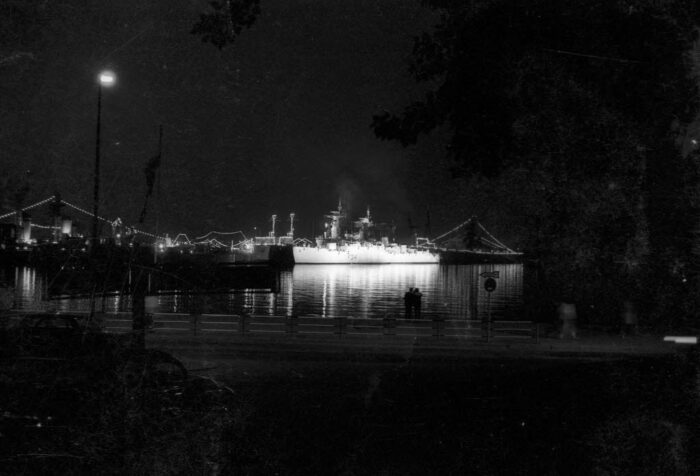
HMS Puma was ordered on 28 June 1951 to Scotts Shipbuilding and Engineering Co Ltd, Greenock, laid down on 16 November 1953, launched on 30 June 1954 and completed on April 1957 at HM Dockyard, Chatham, with British Polar Engines Ltd, Glasgow providing the engines. She was commissioned on 27 April 1957 at a cost of £2,914,000. In 1958, Puma was in Portland. She visited ports in Europe as well as Africa and South America and the US base of Diego Suarez. In 1958-1960 this was under command of Richard Clayton. Paid off at Plymouth in 1961 she took part in naval exercises and was in the Iceland Patrol. In October 1962 she stopped at Tristan da Cunha, to prepared for the return of its residents after being evacuated (eruption of the volcano Queen Mary, 1961). But she struck a reef there, damaging her port propeller. She was repaired in Cape Town and Gibraltar.
She then had a major refit in Portsmouth (1963-1964) and, by 1965, toured the UK recruiting. In 1966, she toured West and South Africa and the South Atlantic, South America, and back to Plymouth in 1967. She was refitted in 1967 for a few months and made another round the world deployment via South Africa, Singapore, Hong Kong, Australia, San Francisco, Monterey, Panama and across the Atlantic back home. In 1971, she was in Fishery Protection patrol, Arctic and Barents Seas, from the advanced base Honningsvag in Norway. She was paid off at Chatham in early 1972, and later sold for BU.
 F37 HMS Jaguar
F37 HMS Jaguar
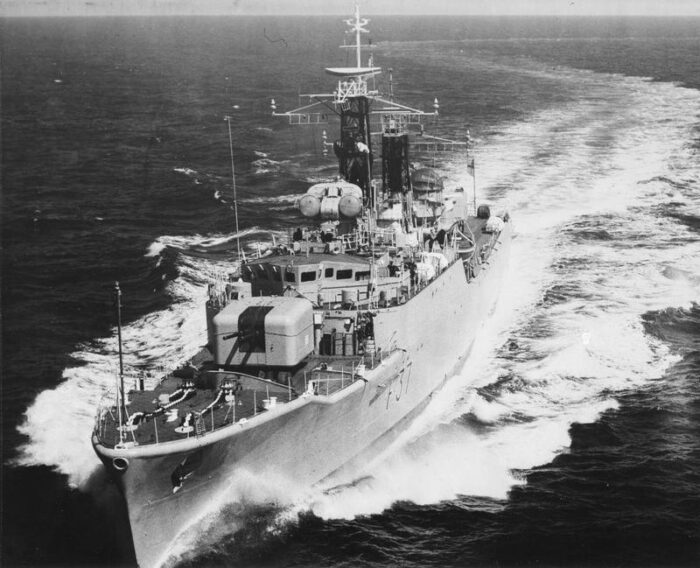
HMS Jaguar was ordered to Wm Denny Bros Ltd, Dumbarton on 28 June 1951, laid down on 2 November 1953 and completed on 20 July 1957. Her engines came from Crossley Bros Ltd, Manchester. She was completed on December 1959 and commissioned on 12 December at a cost of £3,772,000. Initially, her twin STAAG mounting was replaced by a 40 mm gun. She was refitted also in the mid-1960s with Type 965 air warning radar and her lattice mainmast replaced by a plated structure for the new AKE1 aerial of the Type 965. She also swapped her Type 293Q target designation radar for a Type 993 and had new ESM and SCCM equipment on her foremast. The installation of a Seacat was not done for budget-cutting.
She left Chatham in January 1969 for a world cruise via Gibraltar, South Africa, Mombasa, Singapore, Hong Kong, New Zealand, Australia, Tasmania, Fiji, Tonga, Raratonga, Tahiti, Pitcairn, Panama and Florida. She sent her medical team to the Seychelles for an emergency. Likewise, she was home for Xmas 1969. The next year, she was deployed in Icelandic waters as part of the “Second Cod War” in 1973. On 10 September, she was “bumped” by the Icelandic gunboat Thor (Þór), while trying to deter her to intervene on trawlers. She spent the rest of the month on dry dock at Chatham. She was assigned to the standby squadron, recommissioned in 1976 and took part in the third Cod War. Bows and stern were fitted with heavy wooden sheathing for more “bumping”.
She spent time in reserve, until sold on 6 July 1978 to the Bangladesh Navy (£2 million deal) recommissioned in 1978 as BNS Ali Haider (F17). The latter was decommissioned in Chittagong on 22 January 2014. She and her other sister were replaced by Jianghu-III Frigates.
The Indian Brahmaputra class
 F34 INS Brahmaputra
F34 INS Brahmaputra
INS Brahmaputra was originally ordered as HMS Panther, but transferred to India in 1953. She had been laid down at John Brown and Co Ltd, Clydebank on 20 October 1955, launched on 13 March 1957 and commissioned on 31 March 1958. She was decommissioned on 30 June 1986 and Broken Up in 1986.
 F37 INS Beas
F37 INS Beas
INS Beas was ordered by the INS at Vickers Armstrongs, Newcastle upon Tyne in 1954, laid down on 29 November 1956, launched on 9 October 1958[ and commissioned on 24 May 1960. She was decommissioned on 22 December 1992 and BU.
 F38 INS Betwa
F38 INS Betwa
INS Betwa was ordered to Vickers Armstrongs in 1954, laid down on 29 May 1957, launched on 15 September 1959 and commissioned on 8 December 1960. She was decommissioned on 31 December 1991, BU in 1998.
Read More/Src
Books
Conway’s all the world’s fighting ships 1947-95.
Colledge, J. J.; Wardlow, Ben & Bush, Steve (2020). Ships of the Royal Navy. Barnsley, UK: Seaforth Publishing.
Royal Navy Frigates 1945-1983″ Leo Marriott, Ian Allan, 1983.
Moore, George, “The dawn of the Salisbury, Leopard and Whitby class frigates” in Warship, 2004, Conways, 2004
Purvis, M.K., “Post War RN Frigate and Guided Missile Destroyer Design 1944–1969”, Transactions of the Royal Institution of Naval Architects 1974
Marriott, Leo, Royal Navy Frigates Since 1945, Second Edition, Ian Allan, Surrey, 1990
Colledge, J. J.; Warlow, Ben (2006) [1969]. Ships of the Royal Navy, Complete Record, Chatham Publishing.
Capt. John E. Moore, Warships of the Royal Navy; New Edition, Jane’s Publishing, 1981.
D. K. Brown & George Moore, Rebuilding the Royal Navy. Warship design since 1945, Chatham Publishing, 2003
Links
rmg.co.uk/ leopard class plans
en.wikipedia.org Leopard-class_frigate
shipsnostalgia.com
worldnavalships.com/
battleships-cruisers.co.uk
Model Kits
3D
https://www.artstation.com/artwork/BXBZwl

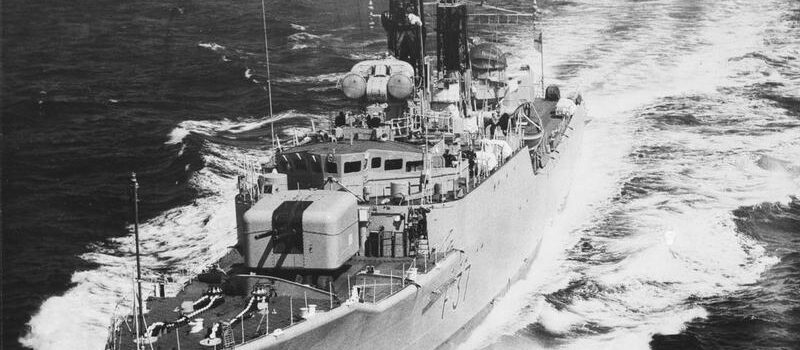
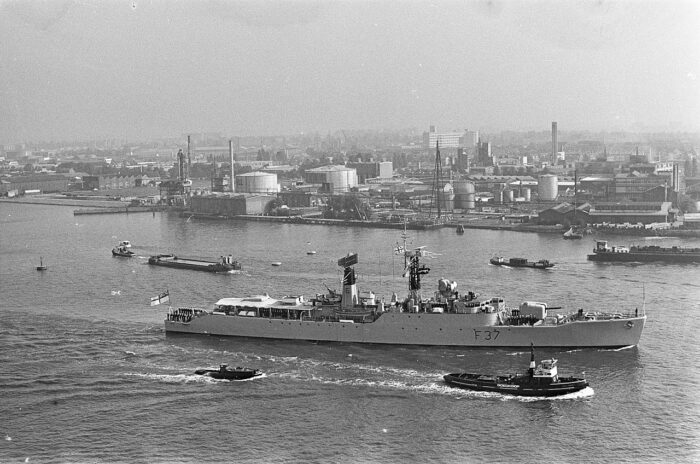
 Latest Facebook Entry -
Latest Facebook Entry -  X(Tweeter) Naval Encyclopedia's deck archive
X(Tweeter) Naval Encyclopedia's deck archive Instagram (@navalencyc)
Instagram (@navalencyc)


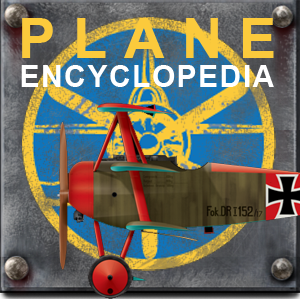
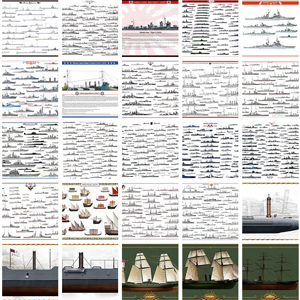

 French Navy
French Navy Royal Navy
Royal Navy Russian Navy
Russian Navy Armada Espanola
Armada Espanola Austrian Navy
Austrian Navy K.u.K. Kriegsmarine
K.u.K. Kriegsmarine Dansk Marine
Dansk Marine Nautiko Hellenon
Nautiko Hellenon Koninklije Marine 1870
Koninklije Marine 1870 Marinha do Brasil
Marinha do Brasil Osmanlı Donanması
Osmanlı Donanması Marina Do Peru
Marina Do Peru Marinha do Portugal
Marinha do Portugal Regia Marina 1870
Regia Marina 1870 Nihhon Kaigun 1870
Nihhon Kaigun 1870 Preußische Marine 1870
Preußische Marine 1870 Russkiy Flot 1870
Russkiy Flot 1870 Svenska marinen
Svenska marinen Søværnet
Søværnet Union Navy
Union Navy Confederate Navy
Confederate Navy Armada de Argentina
Armada de Argentina Imperial Chinese Navy
Imperial Chinese Navy Marinha do Portugal
Marinha do Portugal Mexico
Mexico Kaiserliche Marine
Kaiserliche Marine 1898 US Navy
1898 US Navy Sovietskiy Flot
Sovietskiy Flot Royal Canadian Navy
Royal Canadian Navy Royal Australian Navy
Royal Australian Navy RNZN Fleet
RNZN Fleet Chinese Navy 1937
Chinese Navy 1937 Kriegsmarine
Kriegsmarine Chilean Navy
Chilean Navy Danish Navy
Danish Navy Finnish Navy
Finnish Navy Hellenic Navy
Hellenic Navy Polish Navy
Polish Navy Romanian Navy
Romanian Navy Turkish Navy
Turkish Navy Royal Yugoslav Navy
Royal Yugoslav Navy Royal Thai Navy
Royal Thai Navy Minor Navies
Minor Navies Albania
Albania Austria
Austria Belgium
Belgium Columbia
Columbia Costa Rica
Costa Rica Cuba
Cuba Czechoslovakia
Czechoslovakia Dominican Republic
Dominican Republic Haiti
Haiti Hungary
Hungary Honduras
Honduras Estonia
Estonia Iceland
Iceland Eire
Eire Equador
Equador Iran
Iran Iraq
Iraq Latvia
Latvia Liberia
Liberia Lithuania
Lithuania Mandchukuo
Mandchukuo Morocco
Morocco Nicaragua
Nicaragua Persia
Persia San Salvador
San Salvador Sarawak
Sarawak Uruguay
Uruguay Venezuela
Venezuela Zanzibar
Zanzibar Warsaw Pact Navies
Warsaw Pact Navies Bulgaria
Bulgaria Hungary
Hungary

 Bundesmarine
Bundesmarine Dutch Navy
Dutch Navy Hellenic Navy
Hellenic Navy Marina Militare
Marina Militare Yugoslav Navy
Yugoslav Navy Chinese Navy
Chinese Navy Indian Navy
Indian Navy Indonesian Navy
Indonesian Navy JMSDF
JMSDF North Korean Navy
North Korean Navy Pakistani Navy
Pakistani Navy Philippines Navy
Philippines Navy ROKN
ROKN Rep. of Singapore Navy
Rep. of Singapore Navy Taiwanese Navy
Taiwanese Navy IDF Navy
IDF Navy Saudi Navy
Saudi Navy Royal New Zealand Navy
Royal New Zealand Navy Egyptian Navy
Egyptian Navy South African Navy
South African Navy






























 Ukrainian Navy
Ukrainian Navy dbodesign
dbodesign